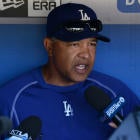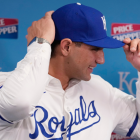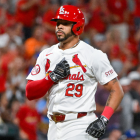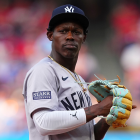This past Saturday night, Dodgers lefty Rich Hill had a perfect game going through seven innings. He'd only thrown 89 pitches and was generally making the Marlins look silly -- save for a deep liner to left that Yasiel Puig snared in an incredible catch.
And then that was it for Hill.
This wasn't just a no-hitter, of which there have been 295 in MLB history -- making it roughly as rare as a two-triple game, though obviously much more ballyhooed. It was a perfect game. There have only been 23 of those. You can't find many individual accomplishments that carry such weight. It's a career-defining moment for pitchers. Hill was just six outs away and he was cruising. Why was he pulled? Via latimes.com:
The trainers inspected Hill's hand after every inning. Hill is combating multiple blisters. One is exacerbated by curveballs. The other is provoked by fastballs. On Saturday, the fastball blister was the one showing signs of life. The staff probed the hand and noted the tenderness of the skin.
Remember, Hill didn't throw an official pitch between July 7 and Aug. 24 due to blister issues (he took the mound on July 17, but departed before the game started).
And, no, Internet Tough Guy, this isn't a pain threshold thing. With blisters on their fingers, pitchers lose command and effectiveness. So he could pitch, but he would not be very efficient and make the blisters worse while he was at it, both hurting his team and pushing back the timeline for when he can help them again.
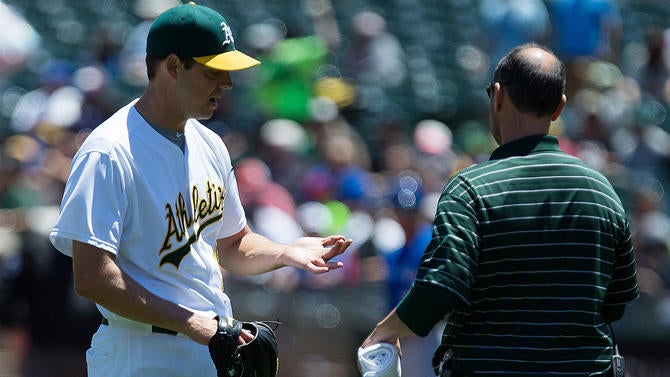
So on one side, you've got manager Dave Roberts thinking about the long-term well-being of his ballclub. They are in first place, their rotation has been decimated by injuries all season and Hill has a 1.80 ERA in 95 innings on the season. If another blister resurfaces, it could conceivably be the end of the season for Hill, judging by how long the blisters lingered last time.
On the flip-side is the human element to the clubhouse and also the fan backlash. In the case of the latter, the overwhelming majority of fans see "pitcher pulled from perfect game due to skin tenderness" and blow a gasket. On the surface, it's hard to blame them. It just sounds ridiculous, doesn't it?
Hill himself insists he was OK to keep going, of course, and was apparently disappointed with the decision ( via latimes.com):
After the game, Hill maintained his composure when speaking to reporters. He did not wish to speak ill of Roberts, who appears to be the favorite to be selected National League manager of the year. But his disappointment was obvious.
Of course he was. He's a competitor and he had a chance at history. Certainly Roberts would probably have been a bit disappointed if Hill did not want to stay in.
For me, though, this situation perfectly illustrates the juggling act managers have to perform. His job is to get his club as far as possible this season. Helping a player achieve an individual goal can be part of the gig at times, but it's definitely secondary.
At least it should be, in the minds of the manager. Sometimes, though, a manager is seemingly held hostage by the pursuit of the no-hitter or perfect game. One example that came to mind was back in mid-August when Mets rookie Steven Matz had a no-hitter going into the eighth. How could it have turned into a nightmare for manager Terry Collins? If it kept going. Matz had an arm injury in 2015 and then was pitching through bone spurs this year. His previous outing came with a season-high 120 pitches. Before the game, Collins talked about wanting to limit Matz, but then a possible no-no was coming into focus.
What's a manager to do there? Damned if you do, damned if you don't, right? Matz would allow a hit and throw 105 pitches. He hasn't thrown a pitch in a game since. Is that related? We can't know, but this type of thing is far more in the consciousness of a manager during a possible no-hitter than it is to a fan.
Collins should know. He helmed the Mets during the first no-hitter in franchise history in 2012. Johan Santana pulled it off on June 1. It took him 134 pitches. It was actually his second straight shutout, lowering his season ERA to 2.38 through 11 starts. Santana would make 10 starts the rest of the season and pitch to an 8.27 ERA. And that was it for his career.
Again, we don't know if that was the fault of that no-hitter. But we know it's been on Collins' mind since then:
Terry Collins feels Dave Roberts' pain about Rich Hill. During Santana's no-hitter, "I wasn't rooting for a hit. I was begging for a hit."
— Anthony DiComo (@AnthonyDiComo) September 11, 2016
Sometimes I do wonder if we're starting to go to the extreme, though, while also ignoring the mentality of professional athletes.
Here's an anecdote to illustrate this point:
During the 2014 World Series, Giants ace Madison Bumgarner was working on a shutout when his teammates spotted him three runs in the bottom of the eighth. It made the score 5-0, meaning the game was pretty much over. Manager Bruce Bochy sent Bumgarner back out for the ninth to complete the shutout and he did it, ending with 117 pitches.
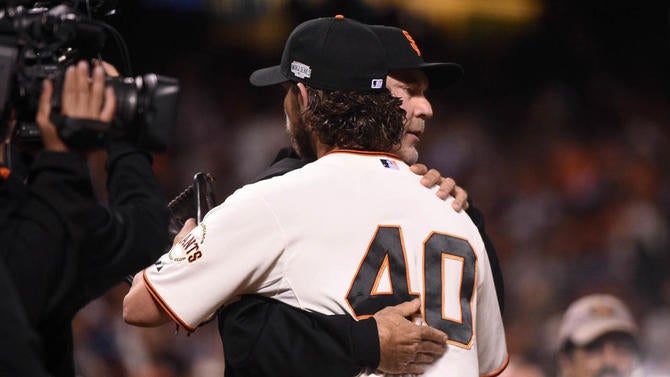
I remember a stream of new-school types lamenting the decision and how Bochy should have saved some of Bumgarner's bullets. I also remember being incredibly annoyed. That's not really how this works. Maybe it should, in the minds of some, but it's not. It's not a video game. Bumgarner would have been livid to be pulled and what if the bullpen inexplicably blew the game? The Giants would have been headed back to Kansas City down three games to two with an upset clubhouse, most notably the ace who carried them to that point.
Again, maybe some people think the players should be more mature and centered, but they just aren't -- especially not during a World Series (or a no-hitter!). You can't change the reality of this in the midst of arguments about what managers should do. They have to consider their players' mentalities.
Maybe some would have been more accepting of being pulled than the uber-intense Bumgarner, but I can't think of many pitchers who wouldn't have put up a fight there. Why bother? Let your man go finish it in that case, absent any symptoms of an injury. He'd shown no signs of slowing down all postseason and, in fact, his arm was essentially bionic at that point.
It wasn't like worrying about if an injury would resurface, such as was the case with Roberts on Saturday.
My point is that every situation is different and the manager is generally the one with the weight of the world on his shoulders as he tries to balance every possible aspect of his ballclub.
What if I pull him and we lose? What if I leave him in and he gets hurt? How do I explain this to the clubhouse even though I think this is the right thing to do?
And on and on the questions must go.
It's pretty easy to proclaim one way or the other what Roberts should have done. On one hand, he's got the training staff telling him there's a chance another few pitches means losing Hill for a length of time. On the other, what if Hill could have finished two more innings without it happening? Taking out Hill carries risk in the human element.
Situations like these are among the reasons managing in the majors is a lot more difficult than "hey, I think we should bunt here!" A decision can affect a season or even a career.









